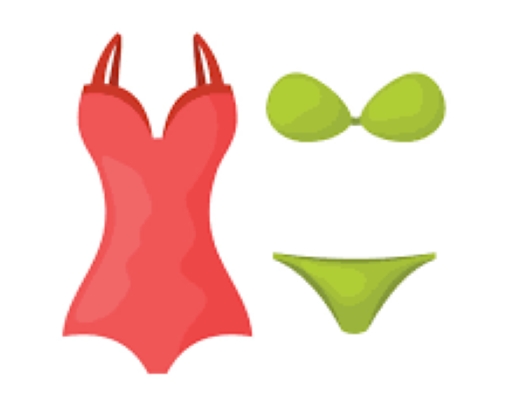How Is A Swimsuit Supposed To Fit? Snug and Comfy Like A Second Skin!
Fitting a swimsuit comes down to sizing. Just measure all the crucial areas. The swimsuit sizing for different areas of the body is as follows:
Torso: 58 inches, 60 inches, 62 inches, 65 inches, 68 inches, 71 inches
Bust: 32–33 inches, 34–35 inches, 36–37 inches, 38–40 inches, 41–42 inches, and 43–45 inches.
Hips: 35–36 inches, 37–38 inches, 39–40 inches, 41–43 inches, 44–46 inches, 47–49 inches
Waist: 26–27 inches, 28–29 inches, 30–31 inches, 32–34 inches, 35–36 inches, 37–39 inches.
Women with extra large busts can get swimsuits with bigger bust areas.
The swimming season, summer, is synonymous with sunshine, laughter, and splashing waves. And incredible fun in the water.
But let’s be honest, the most confidence-boosting factor in any poolside adventure is a swimsuit that fits just right.
Feeling comfortable and supported in your beachwear isn’t just about aesthetics. It’s about enjoying your time without distractions.
Perhaps you are thinking that because you are overweight, you can get away with a loose-fitting swimsuit for plus size women.
Or because you are well-endowed in the chest, you can get away with an ill-fitting swimsuit for women with a large bust.
Fitting is the key to looking, and feeling awesome! Never too tight, never too loose, just right, and snug.
How should a one-piece swimsuit fit? Demystified!

The one-piece swimsuit is a timeless classic that offers endless style options and a secure, comfortable feel.
However, achieving the perfect fit requires understanding how its key components hang on your body:
Torso: The suit should hug your torso comfortably without digging in, allowing for easy movement and breathing when executing your swimming strokes.
Bust: The bust area should offer enough support and coverage, preventing spillage or gaping. Adjustable, wide straps are a big plus.
Hips and legs: The leg openings shouldn’t be too high-cut, causing riding up, nor too low, restricting movement.
Is it better to size up or down in a one-piece swimsuit?
First, I would like to mention that swimsuits come true to size, especially those from renowned brand names.
Of course, there will always be those cheap ones that don’t fit well, but you should avoid such.
Therefore, to the question of ordering one size down or up, there’s no one-size-fits-all answer!
It depends on your personal preference and body type.
Go for your usual size if you prefer a comfortable, and relaxed fit. Consider sizing up if you seek more coverage or have a fuller bust/hip ratio.
Also, sizing down might be suitable if you prefer a snug, supportive fit, or if you have a petite frame.
How do you know if a one-piece bathing suit is too small?
You might order a size down for your swimsuit. However, sometimes, it can feel too small. If you see the following signs, it means your swimwear is too tight!
Digging in: The fabric digs into your skin, leaving red marks or discomfort.
Spillage: The suit fails to contain your bust, leading to gaps or overspill.
Restricted movement: The suit feels tight, hindering your ability to move freely.
Camel toe: The fabric bunches unflatteringly in the front, creating an unwanted bulge.
A bikini conceals pubic hair, so if you see the hair peeping out, it is too small. Also, if it feels too tight on the crotch, it is not your size.
How should swimsuit bottoms fit?

Comfortably. That is the keyword for all types of clothing.
Bikini bottoms come in various styles, but the key to a good fit remains the same. Here are the factors to consider:
Waist: The waistband should sit comfortably without digging in, ensuring it stays put even during water activities.
Coverage: Choose a style that offers the desired level of coverage, from cheeky to full coverage. Consider your comfort level and preferred silhouette.
Leg openings: Similar to one-pieces, the leg openings shouldn’t be too tight or loose, allowing for movement without riding up.
Is it better for the suit to be tight or loose?
Neither extreme is good for you. A swimsuit should be snug but not constricting. It should support your curves without digging in or leaving bulges.
If you find yourself loosening the straps, the swimming attire is too tight. It will look too tight at the seams, and it will be very uncomfortable. In addition, it will be embarrassingly tight at the crotch.
The swimming attire can also be too loose, especially if the bottoms feel like a pair of swimming trunks.
Remember, swimsuits tend to loosen slightly when wet, so a slightly snug fit when dry is usually perfect.
How do you fit a one-piece bathing suit?
A one-piece swimsuit might fit a little differently from a two-piece one. But once more, get the right fit, neither too tight nor too loose.
Here are few tips for fitting:
Know your measurements: Take accurate measurements of your bust, waist, and hips to compare with the brand’s size chart.
Consider your body type: Choose a style that complements your strengths and addresses any concerns you might have.
Try before you buy: Whenever possible, try on the swimwear in person, moving around and ensuring a comfortable fit.
Don’t be afraid to adjust: Many one-piece swimsuits have removable padding and/or adjustable straps. Use them to personalize the fit for optimal comfort and support.
Are one-piece swimsuits supposed to be tight?
No, they shouldn’t be uncomfortably tight. However, a snug fit that supports your curves without restricting movement is ideal.
Think of it like a second skin that allows for confident movement and enjoyable water activities.
The main thing here is to feel comfortable, even when you wear the swimsuit for many hours.
The bikini bottoms should not be uncomfortable in the crotch area. If you are wearing a one-piece suit, it should be comfortable on your back, around the bust and the crotch areas.
You should never experience the need to pull the suit down. If you feel as if it is riding up your thighs, it is not a comfortable fit.
How do I know my one-piece swimsuit size?
The smartest thing is to refer to the swimsuit sizing chart that the sellers provide. But even then, you still need to know that the width and the length of the suit will fit you perfectly.
Therefore, measure the important areas of your body that determine fitting.
As mentioned earlier, accurate measurements and a close look at the brand’s size chart are key.
To know your swimwear size:
Torso: Measure your torso length, from the crotch, over one breast, all the way down the back and back to your crotch.
Chest/Bust: Measure the bust, taking the tape around the biggest area of your bust.
Waist: Measure the waist at its narrowest point, usually at your navel level, by taking the tape measure around.
Hips: Just measure the hips at their widest point.
After noting these measurements, look for a swimsuit that meets all of them.
How do you know if your swimwear is too big?
Here are some signs that will let you know that it is the swimwear wearing you rather than you wearing it:
Gapping: The fabric gaps around your bust, waist, or hips, create a loose and unflattering silhouette.
It rides up: The bottoms or leg openings ride up excessively during movement, causing discomfort and potential exposure.
Lack of support: The suit fails to provide adequate support for your bust, leading to bouncing and discomfort.
Do swimsuits stretch over time? Yes
Swimsuits, especially those with a higher spandex content, can loosen slightly with frequent use and washing. Remember, swimsuits are made of Polyester and elastane/spandex.
Other swimsuits are made of nylon and spandex, and spandex stretches with time.
However, this doesn’t mean a baggy suit will magically transform into a perfect fit. If your swimsuit exhibits signs of being too big from the start, it’s best to replace it for optimal comfort and confidence.
It is also good to follow the instructions for how to wash a swimsuit so that you don’t shorten its lifespan.
How tight should the swimsuit top be?
The top should feel supportive without digging into your shoulders or restricting your breathing.
You should be able to slide two fingers comfortably under the straps. If you have adjustable straps, use them to find the perfect balance between support and comfort.
Remember, when measuring your swimsuit size, you should measure your bust area at its widest point. If you get the bust measurement wrong, the fit is messed up already.
The most common bust sizes for swimsuits are: 32–33 inches, 34–35 inches, 36–37 inches, 38–40 inches, 41–42 inches, and 43–45 inches.
Check my past posts on:
Can I swim in the ocean with a yeast infection?
Can you swim if you have a UTI?
Conclusion
When resting on the pool deck or walking around on the beach, you should be feeling confident and comfortable, not fighting with an ill-fitting suit.
This is why you need to know how a one-piece swimsuit should fit. And it is not too hard, either, because there are sizing charts to help you along.
Measure your bust, torso, hips, and waist before you order your swimsuits from Amazon.com.
